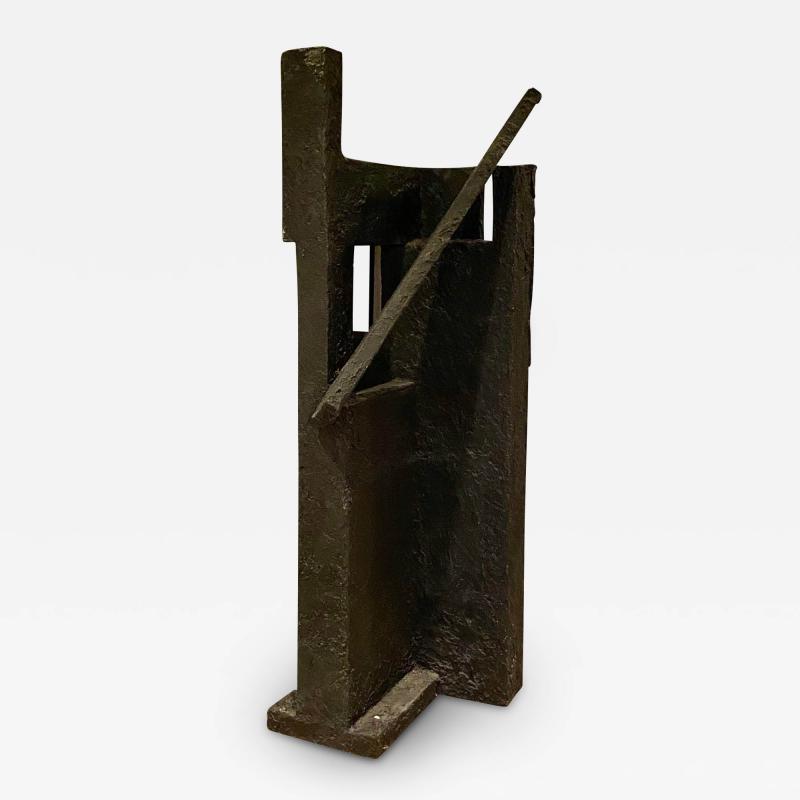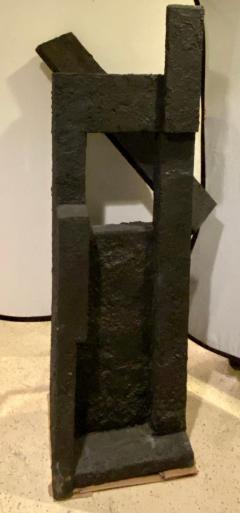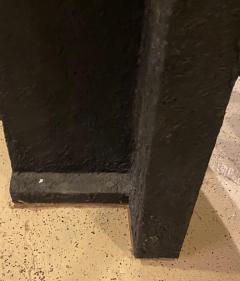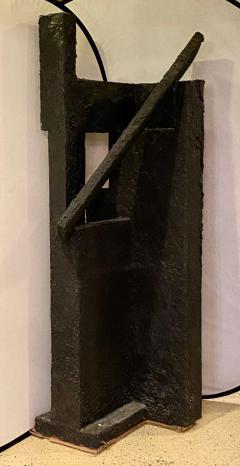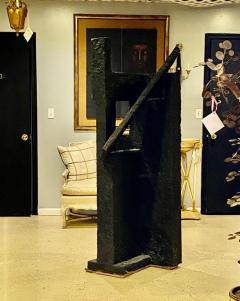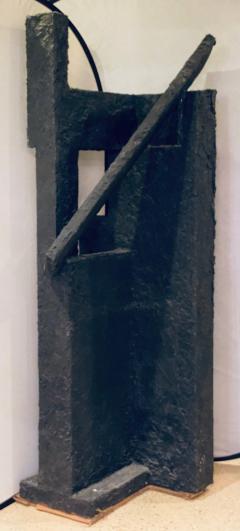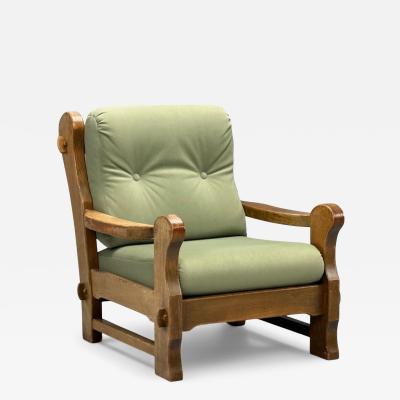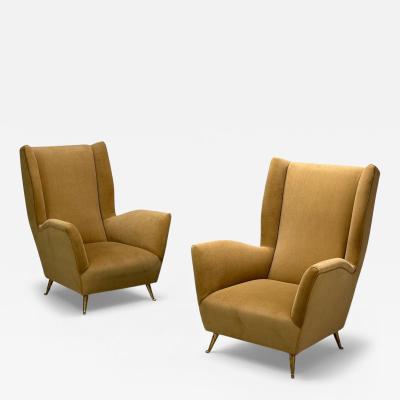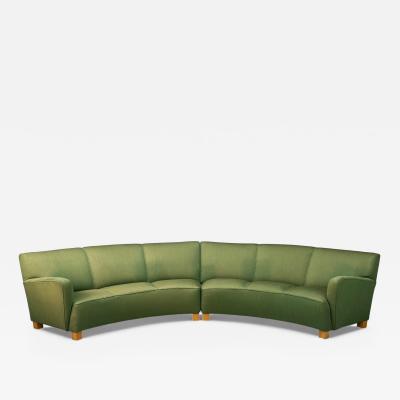Showrooms
Black Geometric Sculpture by Ursula Meyers Conceptual Artist
-
Description
Black geometric sculpture by Ursula Meyers conceptual Artist.
Ursula Meyer (1915-2003) American sculpture signed and dated. This monumental geometric form sculpture is one the first work of art ever offered for sale, only at Greenwich Living, by renowned artist Ursula Meyer. Provenance:
From the Estate of Ann Pollon Re: The Collection of Ursula Meyer. Descendant.
Acquired from the Artist Studio.
Ursula Meyer was a German-born American sculptor, art-focused academician, and fine art
critic, who proved an influential player in the transmission of and appreciation for European born Modernism to the United States in the post-World War II era. At first a ceramicist beholden to the teachings of 1930s Germany’s Bauhaus and Italy’s Futurists, she eventually became a creator and exponent of a crisp, geometry-focused sculptural lexicon in ceramics, and later wood and metal sculpture. Her legacy includes a decades-long exploration of Minimalism, as well as experimentations in creating and deciphering Conceptual and
Expressive genres.
Born in Hanover, Germany in 1915 to Ernst Josef Meyer and Elsa Katzenstein, Ursula Meyer is recorded as having “studied with former Bauhaus masters after the Bauhaus itself had closed under threat of National Socialism” in 1933. Spanning the years 1934 through 1937, Ursula’s Bauhaus tutorial is not fully documented, but it may well have included at least brief study with the French-born Marguerite Friedlaender Wildenhain (1896-1985), the first woman to earn the Master Potter certification in Germany, and who worked with Paul Klee, Wassily Kandinsky, Max Kehan and Gerhard Marcks (1889-1981). Meyer is recorded as having directly worked with Marcks, as well as with Otto Lindig (1895-1966) and the Dutch-born Jan Bonjes Van Week (1899-1969). In 1937, she began formal study at the Reggia Scuola in Faenza, Italy. Here, she further developed her skills as a potter, presumably bridging the organic forms and glazes identified with the pre-Dessau Bauhaus and the more architectonic and heroically Classical models associated with Italy’s Futurist movement that paralleled the reign of Italian dictator Benito Mussolini. As she noted later in life, “art is an inevitable part of the larger order of society, its language and world shared and interdependent with the…’vision’…of its specific Time, Life, place…”
Ursula Meyer emigrated to the United States on the British passenger ship Georgic in June 1939, the manifest of which listed her as “Hebrew,” “Stateless,” and a “Potterer.” A year later, she married Austrian-émigré musician and academician Michael Pollon (1913-1996) in New York. In 1944, she gave birth to the couple’s only child, Ann Caroline Pollon, and in January of the following year, she became a citizen of the United States.
With her marriage and the subsequent birth of her daughter, Ursula Meyer seemed to step away — if only temporarily — from her established career path. But Meyer’s artistic ambitions were not left dormant. Following her 1954 divorce from Pollon, she returned to academic study. She exhibited a group of imposing ceramic vases at the international Expo ‘58 (1958 Brussel’s World’s Fair) — an impressive feat representing a strong commitment to studio productivity that obviously garnered regional and national critical notice. Her work of this time has been assessed by curators as “an interesting link to her slightly later metal and wood sculptures. Though geometric and abstract, the ceramics appear rough and uneven, with deliberately unfinished, expressive surfaces” no doubt beholden to her early Bauhaus influences. Ursula completed her Bachelor of Arts degree at New York’s New School in 1960, and received her Master of Arts degree from Columbia University two years later, at the age of 47. In the fall of 1963, Ursula Meyer’s recognized skill and talent led to her appointment as a professor of sculpture at New York City’s Hunter College. While at Hunter, she participated in numerous landmark exhibitions celebrating Minimalism in art and sculpture, including the serial “Artist-Craftsmen of New York,” organized by New York’s Cooper Union Museum, in 1963, 1964, and 1965. Additional exhibition venues included: the National Design Center (1964; 1965); Artists for CORE (Gallery of American Federation of the Arts — New York; 1967); Artists for SEDF (1967); “Cool Art” (Aldrich Contemporary Art Museum — Ridgefield, Connecticut; 1967); “Schemata 7” (Finch College Museum of Art — New York; 1967). Of these exhibitions,
Meyer included works representing a refinement of her evolving design lexicon. At this point, she resisted the application or integration of texture to her favored geometric forms — particularly the square. And scale became less restrictive or suppressed, with her works taking on a greater monumentality and importance. Her “Homage to Tiny Alice” — presumably a reference to Edward Albee’s controversial 1965 three act play, “Tiny Alice,” which addressed financial corruption in religion — (1967) was among her most celebrated works, and it was included in the Newark Museum’s 1968 exhibition “Cool Art: Abstraction Today,” where it was
showcased beside the works of Sol LeWitt and Robert Smithson.
From 1968 through the 1980 academic year, Meyer served as Associate Professor of Art at Herbert Lehman College, City University of New York. Here, she had her greatest influence as an artist and academician. She perfected her Minimalist, Euclidean-based vocabulary, concentrating on unadorned, precise manipulations of squares, triangles, and other geometric forms. Whether as initial sketches, maquettes, or full-scale sculptures, her works at this time conveyed an even greater monumentality that appealed to Modern Art museum curators and then contemporary architects designing new, multi-purpose public gathering spaces, alike. Meyer exhibited in a number of group shows, and her work was also honored with a series of solo exhibitions at the Hunter College Art Gallery (1968), the Herbert H. Lehman College Art Gallery (1971), and the City University of New York’s Graduate Center (1974). Long-term installations of her sculpture on the campuses of CUNY paralleled these exhibitions, while her work entered into the permanent collections of the Finch College Museum (no longer extant), The Brooklyn Museum, The Newark Museum, and the Aldrich Contemporary Art Museum. As an art critic in a volatile era of war protests and cultural revolution, Meyer became increasingly political, participating in such important demonstrations and reform efforts as the short-lived but influential Art Workers’ Coalition, which was formed in 1969 in protest of the restrictive policies of institutions like New York’s Museum of Modern Art. The AWC successfully secured the establishment of free admission days at MoMA and other New York museums, as well as the public identification of shortcomings regarding the celebration of work
by women and other minorities.
As a writer on art, Ursula Meyer is probably best known for her 1972 book, “Conceptual Art” — an exploration of the then burgeoning genre whereby the idea presented by the artist is viewed as more important than a finished product, if there is, indeed, one. Through a thoughtful and dense text, Meyer explored the works of such artists as Vito Acconci, Terry Atkinson, David Bainbridge, as well as others. This is perhaps her best remembered contribution to the art world, and it still remains a pertinent introduction to the genre that she, herself would explore following her 1980 retirement from the City University of New York. Following her retirement, Ursula Meyer continued to create in her studio and at her desk — expressing her artistic vision, while also serving as a critic, consultant, and lecturer. Meyer died in 2003, leaving a remarkable body of work, spanning nearly six decades. She is counted as an influential voice of the American Minimalist movement of the 1960s — a promoter of the “interplay of transiency and stability” in art.
James Archer Abbott
Art Historian, Curator, and Museum Director
Author Jansen Furniture. Maison Jansen
Designing Camelot. -
More Information
Documentation: Documented elsewhere (similar item) Origin: United States Period: 1950-1979 Materials: Wood, Hand-Crafted. Condition: Good. Wear consistent with age and use. Minor fading. Creation Date: 1970's Styles / Movements: Modernism Incollect Reference #: 541820 -
Dimensions
W. 23.5 in; H. 73 in; D. 30 in; W. 59.69 cm; H. 185.42 cm; D. 76.2 cm;
Message from Seller:
GREENWICH LIVING DESIGN (est. 1975) is an Antique and 20th Century Art & Design Gallery located in Stamford, CT for over 30 years. Our gallery carries rare and important design objects by both iconic and lesser-known designers from the 18th to the 20th Century – with a focus on 20th Century French design. Recent installations feature Pierre Jeanneret, Maison Jansen, Gio Ponti, Phillip & Kelvin LaVerne, Warren Platner, Ueli Berger, Massimo Vignelli, and many more.















